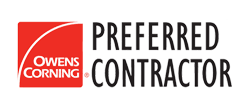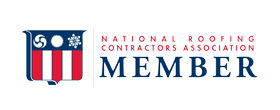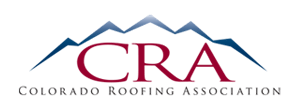National Safety Month: Saving Lives and Preventing Workplace Injury
Choose the Right Roofer

Safety is critical both inside and outside the workplace. As such, the United States’ leading non-profit safety advocate, the National Safety Council (NSC), has designated each June as National Safety Month®. National Safety Month focuses on saving lives and preventing injuries, either in or outside the workplace.
While National Safety Month typically highlights accidental injury from falls, crashes, and other preventable events, in 2020, with the COVID-19 coronavirus, the term “safety” means more than ever considered previously, including safety masks.
Slips, Trips, and Falls
Falls account for the third-highest total unintentional deaths each year in the United States. Fatalities resulting from falls are surpassed only by poisoning (including deaths from drugs and medicines) and motor vehicle crashes.
Beyond fatal injuries, the top three leading causes of work-related injuries are:
- Overexertion and bodily reaction
- Slips, trips, and falls
- Contact with objects and equipment
Combined, these three causes account for more than 84% of all nonfatal injuries involving days away from work.
Fall safety should be a top priority, especially in the roofing industry. Construction workers are at the most risk for fatal falls from height, but falls can happen anywhere, and it is essential to recognize potential hazards, both on the job and off. Plan and use the right equipment.
Overexertion and bodily reaction include:
- Non-impact injuries: Result from excessive physical effort directed at an outside source; common activities include lifting, pushing, turning, holding, carrying, or throwing
- Repetitive motion: Microtasks resulting in stress or strain on some part of the body due to the repetitive nature of the task, typically without strenuous effort such as heavy lifting
Slips, trips, and falls include the following types of events:
- Slips and trips without falling; injuries occurring when a worker catches himself or herself from falling due to slip or trip
- Falling on the same level; includes tripping, slipping, falling while sitting, and falling onto or against an object on the same level
- Falling to a lower level; includes falling from a collapsing structure, falling through surfaces, and falling from ladders, roofs, scaffolding, or other structures
- Jumping to a lower level, which is different from falls because they are controlled and voluntary
Contact with objects and equipment, including:
- A moving object striking a worker
- A worker striking against an object or equipment, including bumping into, stepping on, kicking, or being pushed or thrown onto an object
- A part of a worker’s body being squeezed, pinched, compressed or crushed in equipment, between shifting objects, between stationary objects, or in a wire or rope
- A worker being struck, caught, or crushed in collapsing structure, equipment, or material
- A worker being injured as a result of friction or pressure between the person and the source of injury
- A worker being injured from vibration
Falls are Preventable
Whether working from a ladder, roof, or scaffolding, it’s essential to plan, assess the risk, and use the right equipment. First, determine if working from a height is necessary or if there is another way to do the task safely. For a roofer, climbing onto and off a ladder and working on a roof is essential.
Millions of people are treated in emergency rooms for fall-related injuries every year. A fall can end in death or disability in a split second, but with a few simple precautions, you’ll be sure to stay safe.
14 Tips for Anyone Using a Ladder
- Discuss the task with coworkers and determine what safety equipment is needed
- Make sure you are appropriately trained on how to use the equipment
- Scan the work area for potential hazards before starting the job
- Make sure you have level ground to set up the equipment
- If working outside, check the weather forecast; never work in inclement weather
- Use the correct tool for the job, and use it as intended
- Ensure stepladders have a locking device to hold the front and back open
- Always keep two hands and one foot, or two feet and one hand on the ladder
- Place the ladder on a solid surface and never lean it against an unstable surface
- A straight or extension ladder should be 1 foot away from the surface it rests on for every 4 feet of height and extends at least 3 feet over the top edge
- Securely fasten straight and extension ladders to an upper support
- Wear slip-resistant shoes and don’t stand higher than the third rung from the top
- Don’t lean or reach while on a ladder and have someone support the bottom
- Never use old or damaged equipment; check thoroughly before use
Metro City Roofing – Focusing on Safety
Metro City Roofing is a proud member of the National Roofing Contractors Association and the Colorado Roofing Association. As part of our membership, we focus on safety and staying current with safety regulations.
We are also certified with the International Code Council (ICC). Roofing ICC certification companies have completed rigorous national standardized testing on roofing code requirements and safety regulations.
Best-In-Class Training and Certifications
Metro City Roofing is fully licensed and insured for your protection, and we focus on safety measures for all members of our crew.
We carry General Liability Insurance and Workers Compensation Insurance. For some steep-slope roof inspections and videos we share with homeowners, we fly a drone. To ensure we’re protecting homeowners property, we carry Drone Insurance too.
In 2020, following the COVID-19 coronavirus, Metro City Roofing abides by social distancing requirements, including maintaining proper social distancing, wearing masks, using hand sanitizer, and more. We are committed to ensuring our customers are safe and offer no-contact services, even completing contracts and signatures electronically. Safety is our top concern.
Are you looking for the best Denver roofing company?
Metro City Roofing is the #1 roofing contractor recommended by local insurance agents across the Denver metro area.
Request free roof inspectionMetro City Roofing has taken the SafeAtWork pledge with the National Safety Council to:
- Never compromise my own safety or the safety of my coworkers to get the job done
- Actively look for hazards, promptly report them, and take appropriate action to warn others
- Be a good safety role model for my friends and family even when off the job
Why Choose Metro City Roofing?
Metro City Roofing is a Colorado roofing company, headquartered in Denver, CO. We specialize in hassle-free professional roofing and will treat your home like our own.
We deliver the best professional roofing services across the Denver metro area. We are proud of the excellent reputation we've earned, with outstanding customer satisfaction, one roof, and one customer at a time.
REQUEST FREE ROOF INSPECTION








